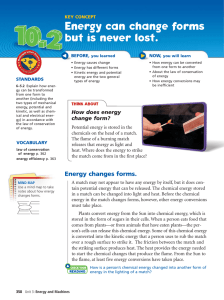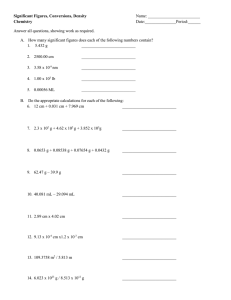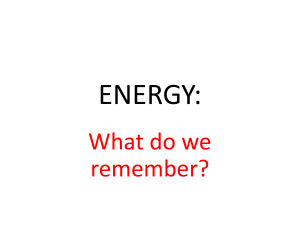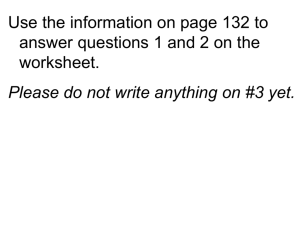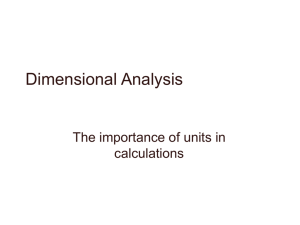Do Now
advertisement
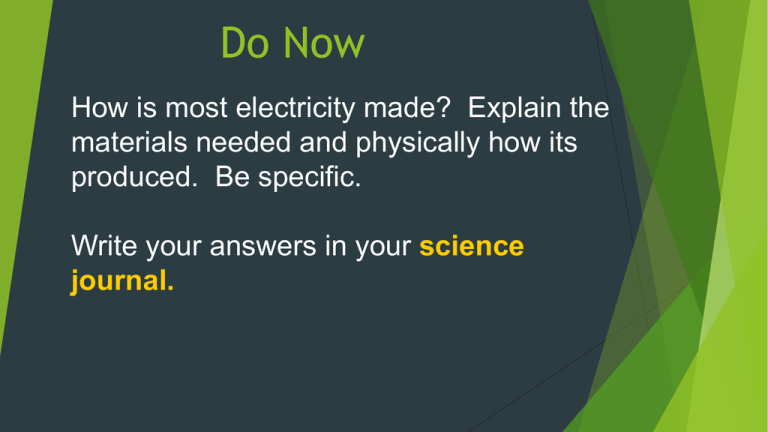
Do Now How is most electricity made? Explain the materials needed and physically how its produced. Be specific. Write your answers in your science journal. Do Now List 5 forms of energy and give an example for each. Write your answers in your science journal. Big Idea PS3.A: Definitions of Energy Temperature is a measure of the average kinetic energy of particles of matter. The relationship between the temperature and the total energy of a system depends on the types, states, and amounts of matter present. (MS-PS3-3),(MS-PS3-4) PS3.B: Conservation of Energy and Energy Transfer When the motion energy of an object changes, there is inevitably some other change in energy at the same time. (MSPS3-5) •Objectives: Describe an energy conversion. Give examples of energy conversions for the different forms of energy. Vocabulary Explain the law of conservation of energy. Give examples of how thermal energy is always a result of energy conversion. Agenda Learning Target Today I will: learn how energy is transformed. So that I can: identify and describe different transformations of energy. I will know I got it if: I can clearly explain how energy is transformed in at least 3 different situations. Today we will: Learn about energy transformation. Complete a group activity Complete an individual activity Exit ticket Energy conversion Law of conservation of energy kinetic energy potential energy mechanical energy thermal energy chemical energy electrical energy sound energy light energy nuclear energy Wind energy Water energy Video: https://www.youtube.com/watch?v=n44K8Irp gpw&list=PLNNCUNuTXfdEIeuE-uGoP19Z7zET07XJ Describe another example of an energy conversion you may be familiar with. Kinetic Energy and Potential Energy • An energy conversion is a change (using a “machine” or process) from one form of energy to another. Any form of energy can change into any other form of energy. • As the skateboarder on the next slide travels up and down the half-pipe, his energy changes back and forth between kinetic energy and potential energy. Conversions Involving Chemical Energy • Chemical energy is stored in the food you eat. Your body uses this chemical energy to function. • Energy Conversion in Plants The chemical energy in the food you eat comes from the sun’s energy. Plants use photosynthesis to convert light energy into chemical energy, as shown on the next slide. Potential Energy Conversions Involving Chemical Energy, continued • The Process Continues Plants change light energy into chemical energy. The chemical energy in the food you eat is changed into another kind of chemical energy that your body can use. • Your body then uses that energy to give you kinetic energy that you use in everything you do. Why Energy Conversions Are Important • Energy conversions are needed for everything we do. Heating our homes, getting energy from a meal, and many other things use energy conversions. • Machines, such as a hair dryer, help harness energy and make that energy work for you. Why Energy Conversions Are Important, continued • Conversions Involving Electrical Energy Some common energy conversions that involve electrical energy are shown in the table below. Where Does the Energy Go? • Friction is a force that oppose motion between two surfaces that are touching. • For a roller coaster car to move, energy must be used to overcome the friction between the car’s wheels and the track. • As a result, not all of the car’s potential energy changes into kinetic energy and not all of the car’s kinetic energy changes back into potential energy. Energy Is Conserved Within a Closed System • A closed system is a group of objects that transfer energy only to each other. • The Law of Conservation of Energy states that energy cannot be created or destroyed. • Energy can be converted from one form to another. But all of the different forms of energy in a system always add up to the same total amount of energy. Energy Is Conserved Within a Closed System, continued • The image below shows energy conservation in a light bulb. No Conversion Without Thermal Energy •Any time one form of energy is converted into another form, some of the original energy always gets converted into thermal energy. • The thermal energy due to friction that results from energy conversions is not usually useful energy. Exit Ticket How does energy transform or change from one form to another? Give an example.
